On the afternoon of March 16, 2018, a man riding his motorcycle along the bank of the Liao River near Shenyang, Liaoning Province, was surprised to see a flock of large white birds across the river. He stopped and used his mobile phone to take photos, but the noise alarmed the birds, which took flight. Not far away, a group of volunteers was also watching these birds. They were conducting a synchronized migration survey of the white birds – Siberian Cranes.
The Siberian Crane is listed as Critically Endangered on the IUCN Red List, with a global population of only 4,000 birds. Nearly all Siberian Cranes spend the winter in and around Poyang Lake in southeastern China. On migration from their breeding grounds in the Russian Arctic, Siberian Cranes depend on a chain of critical staging sites in the Amur-Heilong River basin of northeast China to rest and refuel on their long journey. This group at the Liao River numbered 118 individuals.
The cranes were stopping over at the Liao River on their journey north from Poyang Lake to rest and feed before the long trip to the breeding grounds thousands of kilometers to the north. Typically, disturbance affects the birds’ ability to prepare for the remainder of their migration. But this time, the situation was a little special.
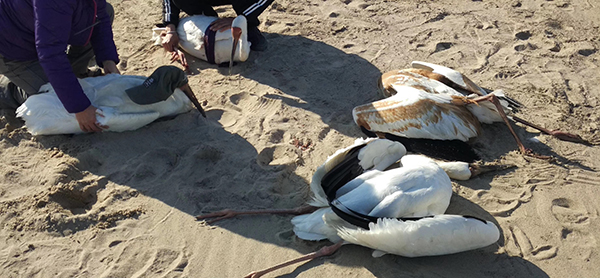
A Race against Time
Three cranes did not fly away with the rest of the group. One was standing nervously, watching the man across the river. Another was lying on the ground with the feathers on its back swaying in the wind. A third one was limping and staggering away from the disturbance. This behavior was clearly not natural. All three of these birds were either injured or sick and in difficulty!
The winter ice covering the Liao River does not begin to melt until March. The river was wide and of unknown depth, and the volunteers could find no trace of wheel marks on the nearby beach. The chances of crossing the broad river, tens of meters across, to reach the wounded cranes was daunting for the volunteers. They decided to divide into two groups. One group would drive to the wounded cranes as fast as they could. The other group would stay to keep watching the cranes. Driving 15 kilometers took 15 minutes. When the volunteers arrived, the two previously standing cranes were lying on the ground. One crane appeared to have no obvious external injuries, but it could not move, and mucus was dribbling from its mouth. Another bird lying on the ground had no heartbeat. The volunteers tried but failed to save it. The third bird was found, still alive. It was clear that these cranes were poisoned. A fourth crane was discovered, lifeless, in the river. It was a young bird, less than one-year-old.
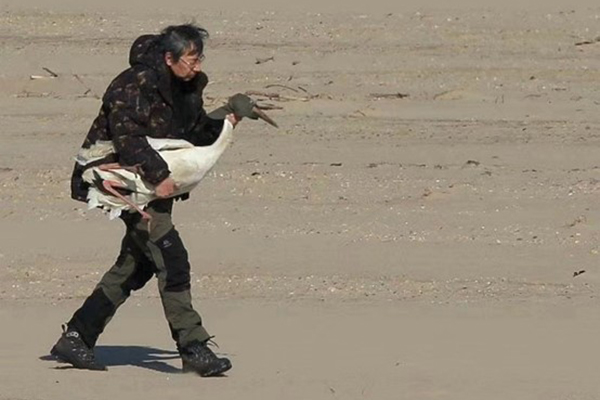
2018 was a particularly difficult year for Siberian Cranes because of the abnormal conditions in the Russian breeding area in 2017. High precipitation in the winter had left a heavy snowpack on the tundra. Spring came late, and when the ice melted it flooded the nesting sites of the cranes, meaning nesting success was close to zero. The proportion of newborn cranes was much lower than the average of 8 percent in previous years. Among the 118 Siberian Cranes stopping over at the Liao River, there may have been only a few fledglings, and now one had been poisoned by humans. The young crane had survived a journey of several thousand kilometers, struggled through a winter of food shortages, only to die from poisoning on a bright spring day in northeast China.
Sadly, the poisoning of cranes is not unusual in this part of China. Cranes are not usually the target. Illegal hunters put out poisoned bait to catch geese and ducks for consumption at home or to sell to restaurants, and cranes can eat the poison accidentally. In addition, spring is the planting season for corn in this area, and corn seeds are often treated with highly toxic pesticides to stop insects from eating the seeds. Sometimes cranes can find and consume these seeds.
The 3,000-mile-long migration of the critically endangered Siberian Crane poses serious difficulties from poisoning, food shortages, habitat loss, and disturbance.
Together, we can confront these threats and protect stopover sites. With your support—we can give these cranes a fighting chance for safe passage. Donate today.
First Meeting with 419
The two remaining poisoned cranes were rescued by the volunteers and sent to Shenyang Bird Rescue Center. During the night, when one of the poisoned cranes stood up, it was discovered that one leg was unnaturally deformed. It curved in the shape of a Z. The crane had also lost a toe. This deformity was likely the result of an earlier injury caused by a bird trap, which normally targets small waterbirds. They are hidden in shallow water like a plate and fixed underground with iron brazing. Once a bird steps on it, the serrated iron bar is released and traps the unfortunate bird by the leg. Due to their large size and the strength of cranes, the trap usually only traps the toes. Some birds can escape by breaking off their toes. Others may pull up the trap and iron braces, but these birds face a severe handicap in walking and flying. This crane lost a toe and broke a leg to break free of the trap, only now to be poisoned. Life is fraught with dangers for Siberian Cranes, but this individual was certainly a survivor!
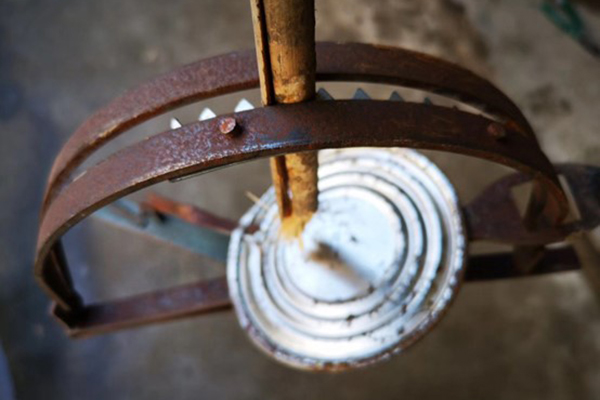
The two cranes had been rescued and were alive, but they were both severely traumatized. It was very difficult for the animal rescue experts to approach the birds, who were easily stressed. They refused to eat the food provided, meaning they could not regain the strength needed to be released safely. After careful consideration and discussion, several animal rescue experts decided to release the cranes at Huanzidong Wetland Park, not far from Shenyang. This wetland is a traditional stopover site for Siberian Cranes, and many rest there during spring migration.
The team fitted a small, solar-powered micro-satellite tracker on the leg of the Siberian Crane with a broken leg and an “identity card” leg band before its release. The leg band was numbered 419, and this became the crane’s name. Through observation, volunteers found that 419 was an older adult Siberian Crane. Upon release, the bird took off flying against the wind, but it was weak and remained suspended in the air for a while before falling to the ground in a field not far away. After looking back at the crowd who saw him off, 419 limped and walked towards the wetland. With one broken leg, it was shaken by the wind every time it took a step. The bird had to spread its wings to maintain its balance until eventually it was blown by the strong wind, and then reluctantly fell back to the ground with that good leg. Again and again, 419 tried to rise and limp towards the safety of the wetland.
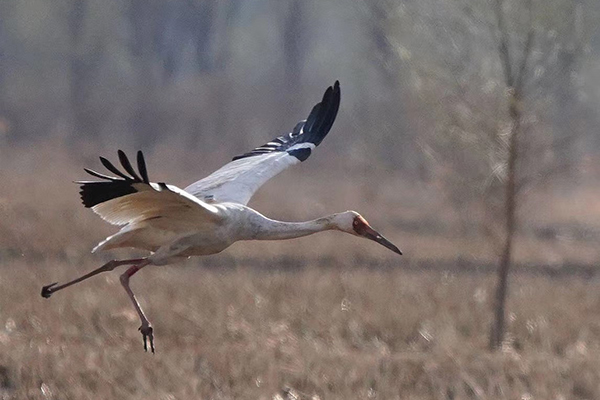
This struggle was heartbreaking to watch for the assembled crowd, and some volunteers could not restrain their tears. Others began to wonder, was it really good for 419 to return to nature like this? Can it survive? Everyone went home, saddened, but somehow hoping for the best. No one was very optimistic.
However, daily satellite tracking and target observations over the next 50 days revealed that 419 remained in Huanzidong Wetland and was active. But after returning to the wetland, 419 always stayed alone, away from the other cranes. Did the other cranes shun him because of his disability? He would seek out patches of long grass, unusual behavior for Siberian Cranes that typically feed in the open shallow waters away from the tall vegetation. During the day, 419 lay down and rested in the long grass, emerging at night to seek food in the wetland all night, while the other cranes slept.
In early May, the Siberian Cranes were well fed and rested, but the urge to migrate north becomes stronger. The snow is beginning to melt on the Arctic tundra. They wait for the wind direction to turn favorable for the migratory journey before leaving in large flocks. What would 419 do? Can he migrate with the other cranes? Is he strong enough? Or will he be forced to stay at Huanzidong, finding refuge in the long grass by day and feeding in the lake at night? The volunteers and rescuers could only wait and hope for the best.
However, one morning, the signal from the tracker showed that 419 flew from Huanzidong to Daqing, in Heilongjiang province, near the Russian border. After stopping overnight in Daqing, he then undertook the marathon journey all the way north across the vast expanses of the boreal forest, on his long journey to the Arctic tundra in extreme northern Russia and the nesting area for Siberian Cranes. The signal transmission from 419 stopped after he left Chinese territory.
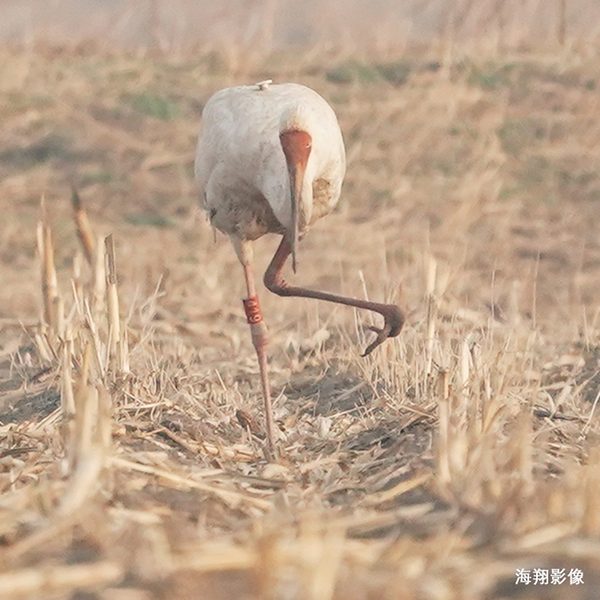
Now, 419’s rescuers and friends in China can only wait. How was he surviving on the tundra? Will he be safe? The tracker would not stop recording its information, but it relies on base station signals within China to return data. As soon as 419 returns to China, all the stored data would finally transmit to the researchers. In other words, only the moment it successfully returns to China would reveal the secret of its life on the breeding ground.
Meeting Again with Surprise
On October 12, 2018, 419’s tracker started recording again – he was back in China! The signal came from a wetland in Inner Mongolia province. The volunteers who saved 419 in the spring rushed to the wetland. The weather was bad with wind and snow. But, the joy of joys, they soon found 419. He was not with the rest of the Siberian Cranes feeding in the wetland. But he was with another Siberian Crane. After several days’ observation, they discovered that the other Siberian Crane was 419’s mate. She stayed faithfully with 419 every moment. The volunteers gave her a name, 4197, which means the wife of 419 in Chinese!
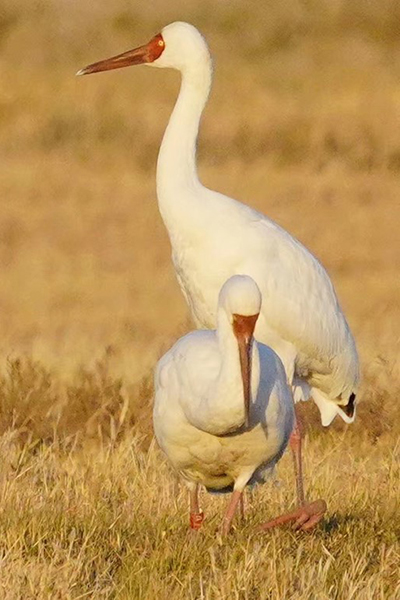
After two years of tracking, 419 did very well and stayed with 4197. Unfortunately, on April 19, 2020, 419 was found alone without 4197 in Tianjin, on the Bohai Bay coast. No one knows what happened to them. When they started migration from Poyang Lake several days earlier, 419 and 4197 were together with 17 other Siberian Cranes. This spring migration was difficult due to strong winds and low temperatures. It must have been particularly difficult for 419.
Volunteers are still receiving data from 419 and tracking his adventures. Every step of the Siberian Crane migration poses difficulties – poisoning, food shortages, habitat loss and disturbance. The migratory path of birds is far more thrilling than we expect. Every year, tens of thousands of migrating birds witness the ecological changes on their migratory routes, as well as the human attitude towards nature.
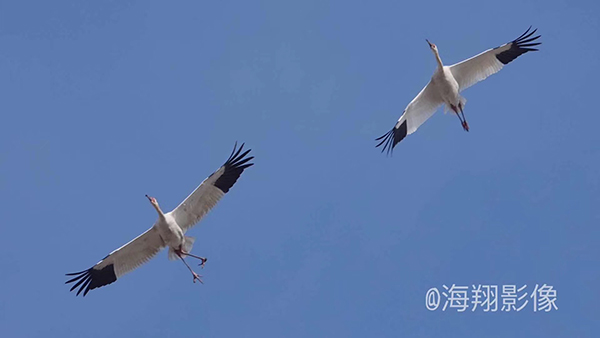
The International Crane Foundation has supported Siberian Crane conservation for more than 40 years, when Co-founder George Archibald, working with Russian and Chinese scientists, helped clarify the species’ migration patterns. The foundation has completed long-term projects with UNEP/GEF and now the Disney Conservation Fund. This work includes crane monitoring and helping conserve the places the birds depend on during their long migrations. To reduce poisoning and trapping incidents, the International Crane Foundation carries out communication and broad crane conservation awareness activities in local communities around stopover habitats. Our activities include distributing crane posters and calendars, conducting environmental education classes in middle and primary schools, and organizing volunteer surveys during the migration seasons. Through these activities, we raise local community awareness, show the beauty of cranes to children and better understand the status of habitats, food and other factors affecting crane migration in Eastern China. Our goal is to make sure Siberian Cranes and other migratory birds have a safe journey every year. We hope more and more people will join us and contribute to our efforts!
Thank you to Professor Zhou Haixiang from Shenyang Science and Technology University, his family and many volunteers who saved 419 and followed this special crane since March 2018. All photos are provided by Prof. Zhou and volunteers.
